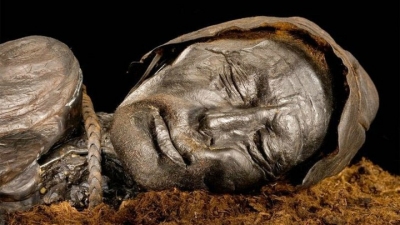
In 1950, the well-preserved body of a man was found in a peat bog in the Jutland Peninsula in Denmark. The police were clueless about its identity, till an archaeologist was called in. He realized that it was someone who had lived during the Iron Age, in around 400 BCE.
A peat bog is formed when moss, grass and other plant debris accumulate in a marshy piece of land. If the climate is cold, the damp acidic setting slows down the decay of this material which becomes carbonized over many years. Eventually it turns into peat, one of the stages in coal formation. Peat not only mummifies anything buried in it, it is also a good fuel and has been used for centuries in Europe. The bogs probably had mystic significance for early man and were popular places for ceremonial sacrifices.
The Tollund Man appears to have been a sacrificial victim. He was clad only in a cap and leather belt and a leather rope was found twisted around his neck. His stomach was miraculously intact and his last meal was a grain porridge contaminated with ergot a fungus that causes hallucinations.
Tollund Man remains one of the best-preserved ‘bog bodies’ ever found. Because methods to preserve the bodies were not known in the fifties, only the original head can be seen at the Silkebord Museum Denmark.
Picture Credit : Google




